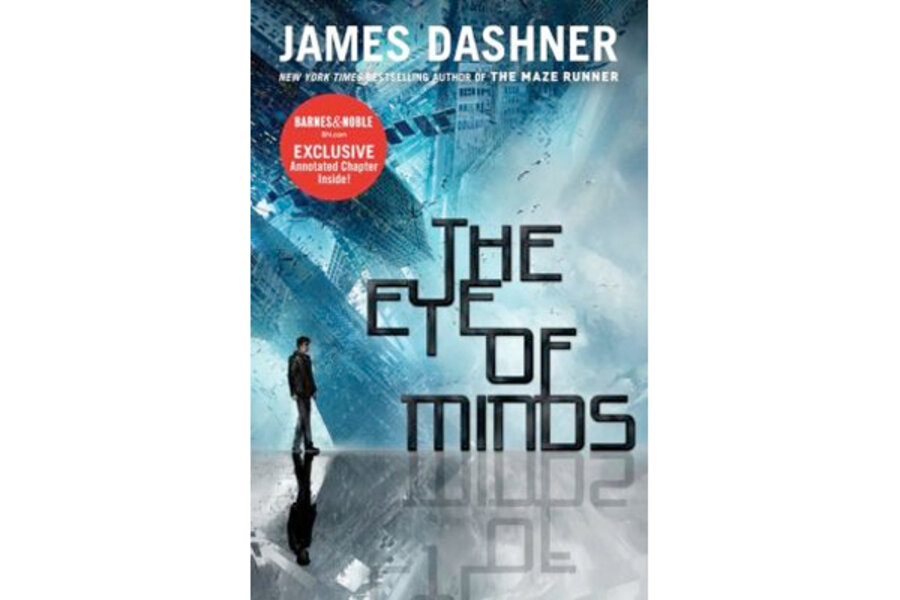The Eye of Minds
You wouldn’t think I could get this excited about another young adult novel so soon after Matthew Quick's Forgive Me, Leonard Peacock, but I fell hard for gaming thriller The Eye of Minds. James Dashner is best known for his dystopian bestseller "The Maze Runner," but he’s outdone himself with "The Eye of Minds," the first installment of "The Mortality Doctrine" trilogy. It’s a brilliant, visceral, gamified mash-up of "The Matrix" and "Inception," and I can’t get enough.
Earlier this year, Dashner spoke to Publisher’s Weekly about "The Eye of Minds," saying, “The idea has been with me a long time. I had the first spark when the Matrix movies came out in the 1990s." He went on to explain, "I kept thinking as I watched them that this certain plot twist was going to happen – but it never did. Then when the movie 'Inception' came out, I was struck by its concept of a dream within a dream. So for 'The Eye of Minds,' I applied this concept to a virtual reality world with that plot twist that never happened, but had always stayed in my head.”
Dashner's story begins with a gamer named Michael, who spends most of his time in the VirtNet, an immersive MMO (massively multiplayer online) video game. The better you are at coding, the wilder a time you can have, and Michael’s a top-shelf programmer. He hangs out with his Virt friends Sarah and Bryson, hacking code and exploring endless fantasy worlds.
But soon the three begin to hear troubling stories about a mysterious gamer called Kaine. Apparently Kaine is holding avatars hostage inside the VirtNet, causing real-life brain damage to the players. There are whispers of players killing themselves to escape the cyber-terrorist and his monstrous creations, called KillSims.
Michael is contacted by the Virtual Network Security (VNS), who have been watching him. All the VNS know about Kaine’s motive is the phrase “The Mortality Doctrine.” They believe it’s some kind of file or program that could damage both the real and virtual worlds. The VNS asks Michael to help find Kaine and identify The Mortality Doctrine.
To do that, Michael must delve into the off-grid VirtNet underworld and follow a digital trail known as the Path. Bryson and Sarah, skilled hackers themselves, volunteer to go with him.
While navigating the Path, Bryson and Sarah are eliminated and sent back to the main VirtNet. Michael must finish the Path alone, facing real danger as the border between fantasy and reality begins to blur. What he discovers is a staggering secret – and a stomach-turning truth about himself. I love well-executed final twists and this one is on par with the cliffhanger in Veronica Roth's "Insurgent."
In many ways, the three friends and their quest in "The Eye of Minds" reminded me of the "Harry Potter" trio Harry, Hermione, and Ron facing the third floor obstacles in "Harry Potter and the Sorcerer’s Stone." Michael is our Harry, “chosen” by the VNS and playing a far larger role than he realizes. Sarah is a perfect Hermione, whip-smart and intuitive. And of course Bryson is Ron – sarcastic and a bit clunky but serving as much-needed comic relief.
Just as Ron and Hermione were stopped in their journey in "Stone," Bryson and Sarah fall victim to the Path, leaving Michael to take on the challenges, the KillSims, and eventually Kaine himself. KillSims are the Death Eaters to Kaine’s Voldemort, though Kaine’s motives are murkier than You-Know-Who’s pure evil.
Dashner writes with a gorgeous, sensory fluidity. Take, for example, the first sight of a KillSim: “it was as if the darkness had melted and splashed onto the floor.” Or Michael’s reaction to a strange offer: “there was a taint there, like a sheen of oil on an otherwise crystal-clear lake. Slick and greasy and wrong, and he couldn’t ignore it.”
And the sleek design of "The Eye of Minds" is pleasing as well. While YA readers tend to cast critical eyes on covers, grumbling about the glut of “Big Face” and ball gowns, this one is graphic, tactile, and gripping, much like Dashner’s prose.
That's not to say that the book succeeds on every level. I have at least two quibbles.
My biggest pet peeve? Dashner’s love affair with his own slang. In both the "Maze Runner" series and "The Eye of Minds," he throws fictional terms around like candy from a parade float. The Sleep, the Wake, the Path, Tangent, Portal, Lift, NewsBops, EarCuff – the constant stream of capitalized vernacular wears quickly, especially in the crucial world-building of early chapters.
There’s also a romantic moment between Michael and Sarah late in the Path that I found unnecessary. While not out of the blue – Dashner places enough body language throughout that it does make sense – it reads like an attempt to make Sarah an emotional sounding board. We already feel Michael’s every emotion through Dashner’s brutal details, though, and the romance feels out-of-place this late in the game.
But for the most part, this is one great book. I’m a writer, reader, and and a gamer – pretty much the perfect audience for "The Eye of Minds." But I'm confident that even for non-gamers will be thrilled and terrified by "The Eye of Minds".
Crank the dubstep and buckle up.
Katie Ward Beim-Esche is a Monitor contributor.






